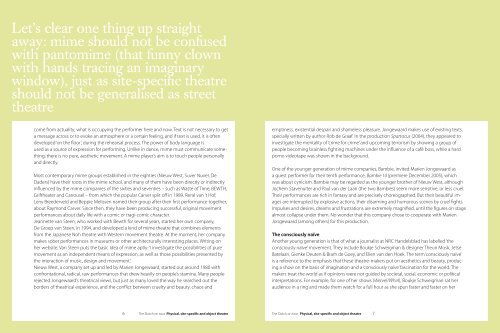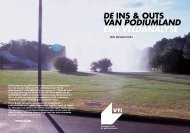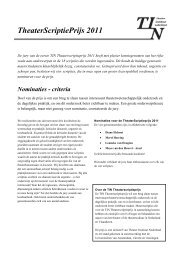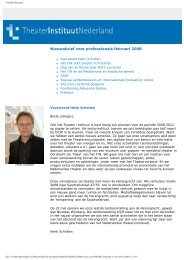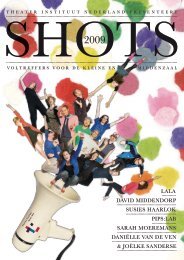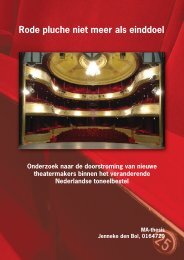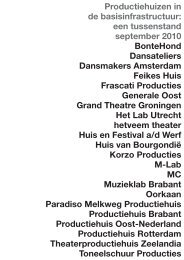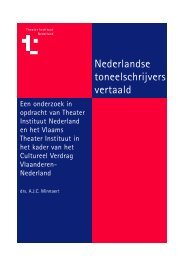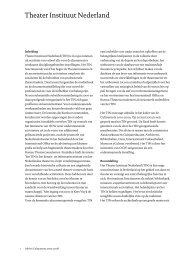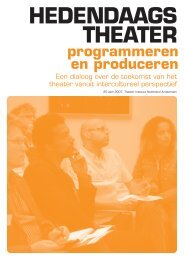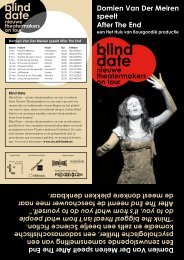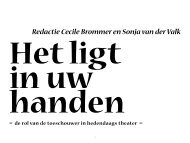T H E D U T C H O N T O U R - Theater Instituut Nederland
T H E D U T C H O N T O U R - Theater Instituut Nederland
T H E D U T C H O N T O U R - Theater Instituut Nederland
You also want an ePaper? Increase the reach of your titles
YUMPU automatically turns print PDFs into web optimized ePapers that Google loves.
Let’s clear one thing up straight<br />
away: mime should not be confused<br />
with pantomime (that funny clown<br />
with hands tracing an imaginary<br />
window), just as site-specific theatre<br />
should not be generalised as street<br />
theatre<br />
come from actuality; what is occupying the performer here and now. Text is not necessary to get<br />
a message across or to evoke an atmosphere or a certain feeling, and if text is used, it is often<br />
developed ‘on the floor’, during the rehearsal process. The power of body language is<br />
used as a source of expression for performing. Unlike in dance, mime must communicate something;<br />
there is no pure, aesthetic movement. A mime player’s aim is to touch people personally<br />
and directly.<br />
Most contemporary mime groups established in the eighties (Nieuw West, Suver Nuver, De<br />
Daders) have their roots in the mime school, and many of them have been directly or indirectly<br />
influenced by the mime companies of the sixties and seventies – such as Waste of Time, BEWTH,<br />
Griftheater and Carrousel – from which the popular Carver split off in 1989. René van ’t Hof,<br />
Leny Breederveld and Beppie Melissen named their group after their first performance together,<br />
about Raymond Carver. Since then, they have been producing successful, original movement<br />
performances about daily life with a comic or tragi-comic character.<br />
Jeannette van Steen, who worked with Bewth for several years, started her own company,<br />
De Groep van Steen, in 1994, and developed a kind of mime theatre that combines elements<br />
from the Japanese Noh theatre with Western movement theatre. At the moment, her company<br />
makes sober performances in museums or other architecturally interesting places. Writing on<br />
her website, Van Steen puts the basic idea of mime aptly: ‘I investigate the possibilities of pure<br />
movement as an independent means of expression, as well as those possibilities presented by<br />
the interaction of music, design and movement.’<br />
Nieuw West, a company set up and led by Marien Jongewaard, started out around 1980 with<br />
confrontational, radical, raw performances that drew heavily on people’s stamina. Many people<br />
rejected Jongewaard’s theatrical views, but just as many loved the way he searched out the<br />
borders of theatrical experience, and the conflict between cruelty and beauty, chaos and<br />
emptiness, existential despair and shameless pleasure. Jongewaard makes use of existing texts,<br />
specially written by author Rob de Graaf. In the production Spartacus (2004), they appeared to<br />
investigate the mentality of ‘crime for crime’ and upcoming terrorism by showing a group of<br />
people becoming brainless fighting machines under the influence of a café boss, while a hard<br />
porno videotape was shown in the background.<br />
One of the younger generation of mime companies, Bambie, invited Marien Jongewaard as<br />
a guest performer for their tenth performance, Bambie 10 (premiere December 2005), which<br />
was about cynicism. Bambie may be regarded as the younger brother of Nieuw West, although<br />
Jochem Stavenuiter and Paul van der Laan (the two Bambies) seem more sensitive, or less cruel.<br />
Their performances are rich in fantasy and are precisely choreographed. But their beautiful images<br />
are interrupted by explosive actions, their disarming and humorous scenes by cruel fights.<br />
Impulses and desires, dreams and frustrations are extremely magnified, until the figures on stage<br />
almost collapse under them. No wonder that this company chose to cooperate with Marien<br />
Jongewaard (among others) for this production.<br />
The consciously naïve<br />
Another young generation is that of what a journalist at NRC Handelsblad has labelled ‘the<br />
consciously naïve’ movement. They include Boukje Schweigman & designer Theun Mosk, Jetse<br />
Batelaan, Gienke Deuten & Bram de Goey, and Elien van den Hoek. The term ‘consciously naïve’<br />
is a reference to the emphasis that these theatre-makers put on aesthetics and beauty, producing<br />
a show on the basis of imagination and a ‘consciously naïve’ fascination for the world. The<br />
makers treat the world as if opinions were not guided by societal, social, economic or political<br />
interpretations. For example, for one of her shows (Wervel/Whirl), Boukje Schweigman sat her<br />
audience in a ring and made them watch for a full hour as she spun faster and faster on her<br />
<br />
The Dutch on tour Physical, site-specific and object theatre<br />
The Dutch on tour Physical, site-specific and object theatre


